2001 BMW 325i SEDAN ignition
[x] Cancel search: ignitionPage 77 of 211
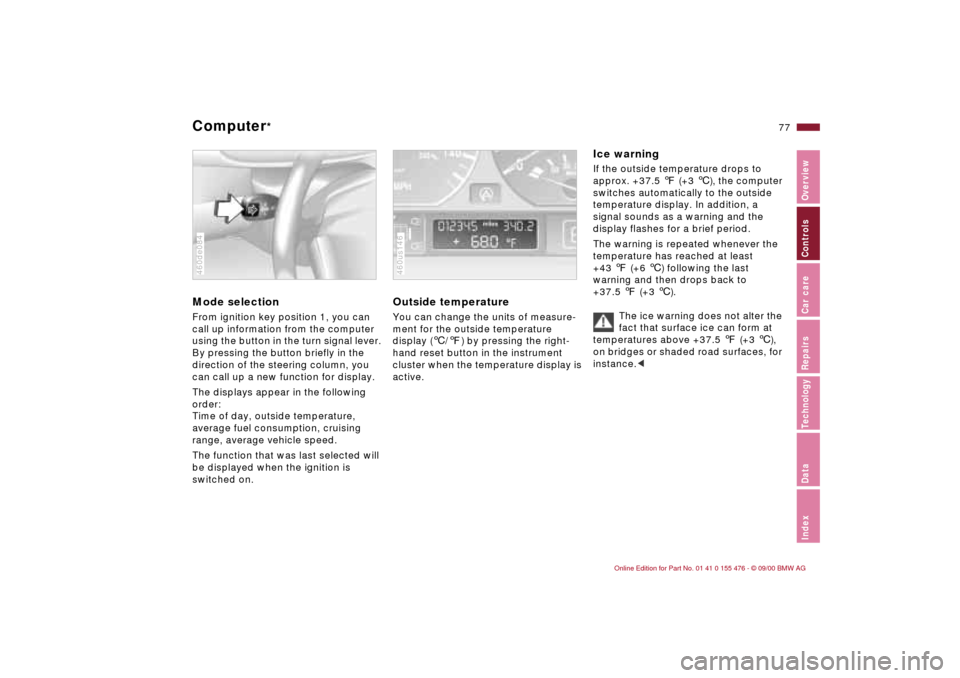
77n
IndexDataTechnologyRepairsCar careControlsOverview
Computer
*
Mode selection
From ignition key position 1, you can
call up information from the computer
using the button in the turn signal lever.
By pressing the button briefly in the
direction of the steering column, you
can call up a new function for display.
The displays appear in the following
order:
Time of day, outside temperature,
average fuel consumption, cruising
range, average vehicle speed.
The function that was last selected will
be displayed when the ignition is
switched on.460de084
Outside temperature
You can change the units of measure-
ment for the outside temperature
display (
6
/
7
) by pressing the right-
hand reset button in the instrument
cluster when the temperature display is
active.
460us146
Ice warning
If the outside temperature drops to
approx. +37.5
7
(+3
6
), the computer
switches automatically to the outside
temperature display. In addition, a
signal sounds as a warning and the
display flashes for a brief period.
The warning is repeated whenever the
temperature has reached at least
+43
7
(+6
6
) following the last
warning and then drops back to
+37.5
7
(+3
6
).
The ice warning does not alter the
fact that surface ice can form at
temperatures above +37.5
7
(+3
6
),
on bridges or shaded road surfaces, for
instance.
<
Page 79 of 211

79n
IndexDataTechnologyRepairsCar careControlsOverview
The conceptThe PDC assists you when you back
into a parking space. A signal warns
you of the distance to an obstacle. To
do this, four ultrasonic sensors in the
rear bumper measure the distance to
the nearest object. The monitoring
range of the two corner sensors
extends to approx. 2 feet (60 cm)
behind the bumper. The two center
sensors cover a distance of approx.
4.9 feet (1.50 meters).
The system starts to operate automati-
cally about one second after you select
reverse with the ignition key in position 2.
PDC is deactivated when you shift back
out of reverse.
Acoustical signalsThe distance to the nearest object is
indicated by a tone sounding at various
intervals. As the distance between
vehicle and object decreases, the inter-
vals between the tones become
shorter. A continuous warning tone
sounds if the distance to a recognized
object is less than 1 foot (30 cm).
The warning signal is canceled after
approx. three seconds if the distance to
the obstacle remains constant during
this time (if you are moving parallel to
a wall, for instance).
System malfunctions will be indicated
by a continuous high-pitched tone
when the system is activated the first
time. Please refer the problem to your
BMW center.The PDC does not remove the
driver's personal responsibility for
evaluating the distance between the
vehicle and any obstacles. Even when
sensors are involved, there is a blind
spot in which objects cannot be
detected. This applies especially in
those cases where the system
approaches the physical limits of ultra-
sonic measurement, as occurs with tow
bars and trailer couplings, and in the
vicinity of thin and painted objects.
Certain sources of sound, such as a
loud radio, could drown the PDC signal
tone.<
Keep the sensors clean and free
of ice or snow in order to ensure
that they continue to operate effec-
tively.
Do not apply high-pressure spray to the
sensors for a prolonged period of time.
Maintain an adequate distance of more
than approx. 4 inches (10 cm).<
Park Distance Control (PDC)
*
Page 80 of 211
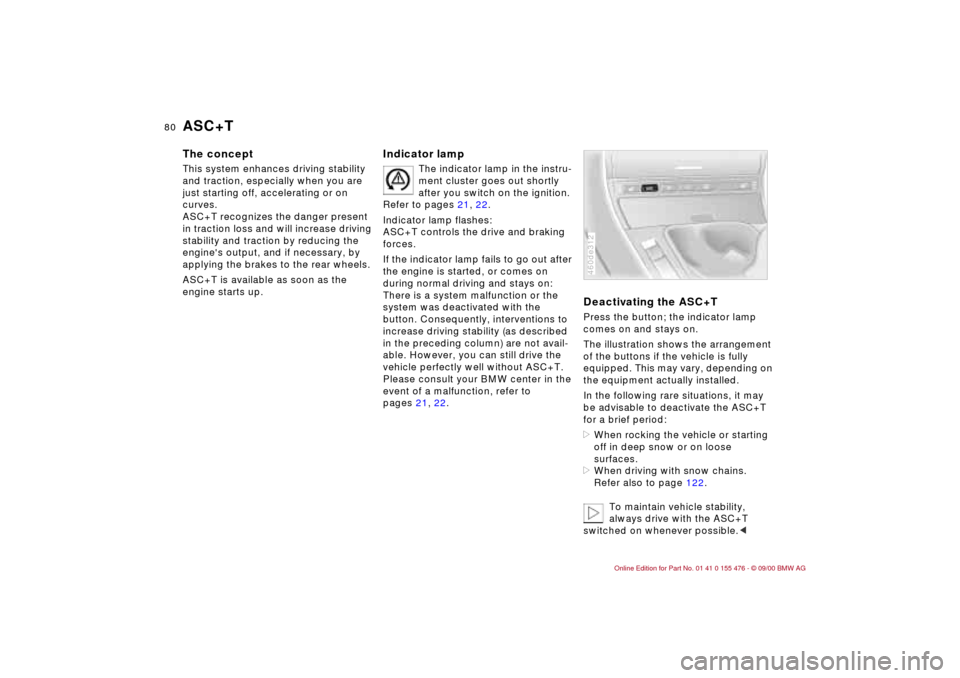
80n
ASC+T The conceptThis system enhances driving stability
and traction, especially when you are
just starting off, accelerating or on
curves.
ASC+T recognizes the danger present
in traction loss and will increase driving
stability and traction by reducing the
engine's output, and if necessary, by
applying the brakes to the rear wheels.
ASC+T is available as soon as the
engine starts up.
Indicator lamp
The indicator lamp in the instru-
ment cluster goes out shortly
after you switch on the ignition.
Refer to pages 21, 22.
Indicator lamp flashes:
ASC+T controls the drive and braking
forces.
If the indicator lamp fails to go out after
the engine is started, or comes on
during normal driving and stays on:
There is a system malfunction or the
system was deactivated with the
button. Consequently, interventions to
increase driving stability (as described
in the preceding column) are not avail-
able. However, you can still drive the
vehicle perfectly well without ASC+T.
Please consult your BMW center in the
event of a malfunction, refer to
pages 21, 22.
Deactivating the ASC+TPress the button; the indicator lamp
comes on and stays on.
The illustration shows the arrangement
of the buttons if the vehicle is fully
equipped. This may vary, depending on
the equipment actually installed.
In the following rare situations, it may
be advisable to deactivate the ASC+T
for a brief period:
>When rocking the vehicle or starting
off in deep snow or on loose
surfaces.
>When driving with snow chains.
Refer also to page 122.
To maintain vehicle stability,
always drive with the ASC+T
switched on whenever possible.<460de312
Page 82 of 211
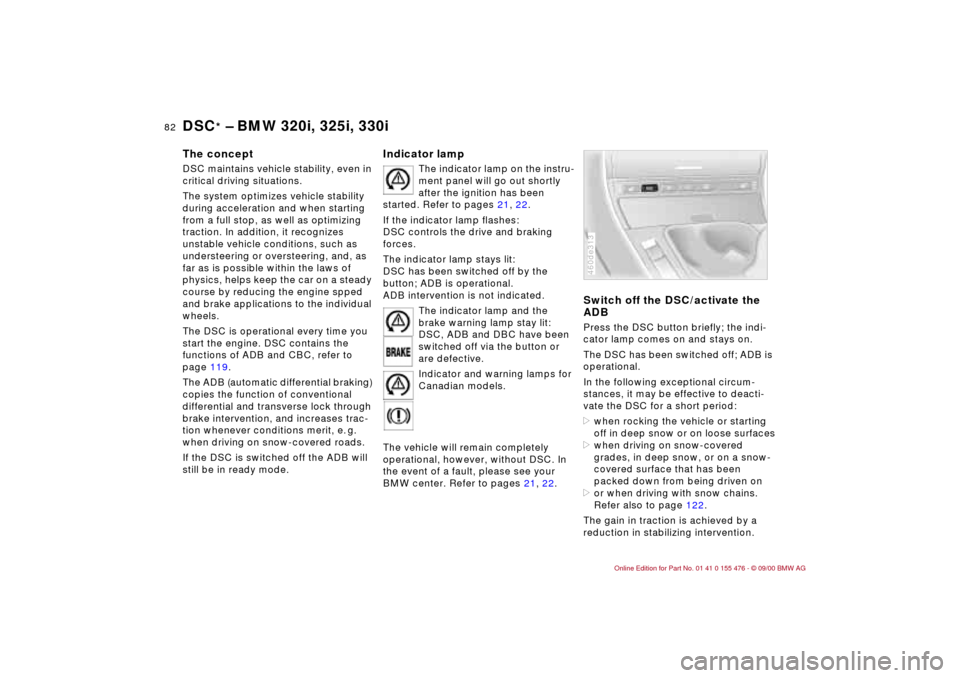
82n
DSC
* Ð BMW 320i, 325i, 330i
The conceptDSC maintains vehicle stability, even in
critical driving situations.
The system optimizes vehicle stability
during acceleration and when starting
from a full stop, as well as optimizing
traction. In addition, it recognizes
unstable vehicle conditions, such as
understeering or oversteering, and, as
far as is possible within the laws of
physics, helps keep the car on a steady
course by reducing the engine spped
and brake applications to the individual
wheels.
The DSC is operational every time you
start the engine. DSC contains the
functions of ADB and CBC, refer to
page 119.
The ADB (automatic differential braking)
copies the function of conventional
differential and transverse lock through
brake intervention, and increases trac-
tion whenever conditions merit, e. g.
when driving on snow-covered roads.
If the DSC is switched off the ADB will
still be in ready mode.
Indicator lamp
The indicator lamp on the instru-
ment panel will go out shortly
after the ignition has been
started. Refer to pages 21, 22.
If the indicator lamp flashes:
DSC controls the drive and braking
forces.
The indicator lamp stays lit:
DSC has been switched off by the
button; ADB is operational.
ADB intervention is not indicated.
The indicator lamp and the
brake warning lamp stay lit:
DSC, ADB and DBC have been
switched off via the button or
are defective.
Indicator and warning lamps for
Canadian models.
The vehicle will remain completely
operational, however, without DSC. In
the event of a fault, please see your
BMW center. Refer to pages 21, 22.
Switch off the DSC/activate the
ADBPress the DSC button briefly; the indi-
cator lamp comes on and stays on.
The DSC has been switched off; ADB is
operational.
In the following exceptional circum-
stances, it may be effective to deacti-
vate the DSC for a short period:
>when rocking the vehicle or starting
off in deep snow or on loose surfaces
>when driving on snow-covered
grades, in deep snow, or on a snow-
covered surface that has been
packed down from being driven on
>or when driving with snow chains.
Refer also to page 122.
The gain in traction is achieved by a
reduction in stabilizing intervention.460de313
Page 84 of 211
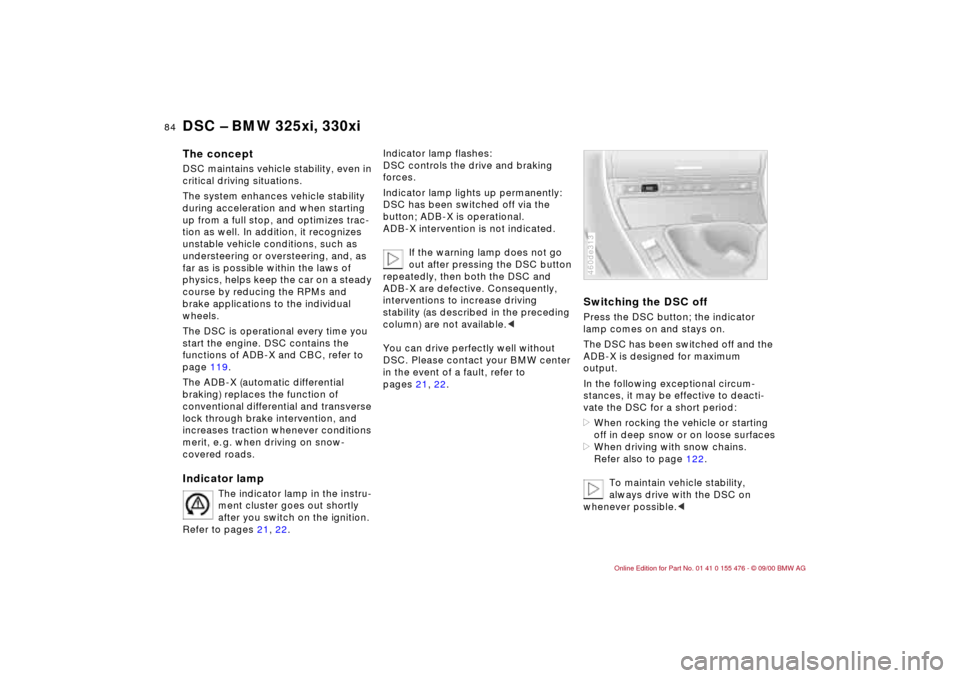
84n
DSC Ð BMW 325xi, 330xiThe conceptDSC maintains vehicle stability, even in
critical driving situations.
The system enhances vehicle stability
during acceleration and when starting
up from a full stop, and optimizes trac-
tion as well. In addition, it recognizes
unstable vehicle conditions, such as
understeering or oversteering, and, as
far as is possible within the laws of
physics, helps keep the car on a steady
course by reducing the RPMs and
brake applications to the individual
wheels.
The DSC is operational every time you
start the engine. DSC contains the
functions of ADB-X and CBC, refer to
page 119.
The ADB-X (automatic differential
braking) replaces the function of
conventional differential and transverse
lock through brake intervention, and
increases traction whenever conditions
merit, e. g. when driving on snow-
covered roads.Indicator lamp
The indicator lamp in the instru-
ment cluster goes out shortly
after you switch on the ignition.
Refer to pages 21, 22.
Indicator lamp flashes:
DSC controls the drive and braking
forces.
Indicator lamp lights up permanently:
DSC has been switched off via the
button; ADB-X is operational.
ADB-X intervention is not indicated.
If the warning lamp does not go
out after pressing the DSC button
repeatedly, then both the DSC and
ADB-X are defective. Consequently,
interventions to increase driving
stability (as described in the preceding
column) are not available.<
You can drive perfectly well without
DSC. Please contact your BMW center
in the event of a fault, refer to
pages 21, 22.
Switching the DSC offPress the DSC button; the indicator
lamp comes on and stays on.
The DSC has been switched off and the
ADB-X is designed for maximum
output.
In the following exceptional circum-
stances, it may be effective to deacti-
vate the DSC for a short period:
>When rocking the vehicle or starting
off in deep snow or on loose surfaces
>When driving with snow chains.
Refer also to page 122.
To maintain vehicle stability,
always drive with the DSC on
whenever possible.<460de313
Page 86 of 211
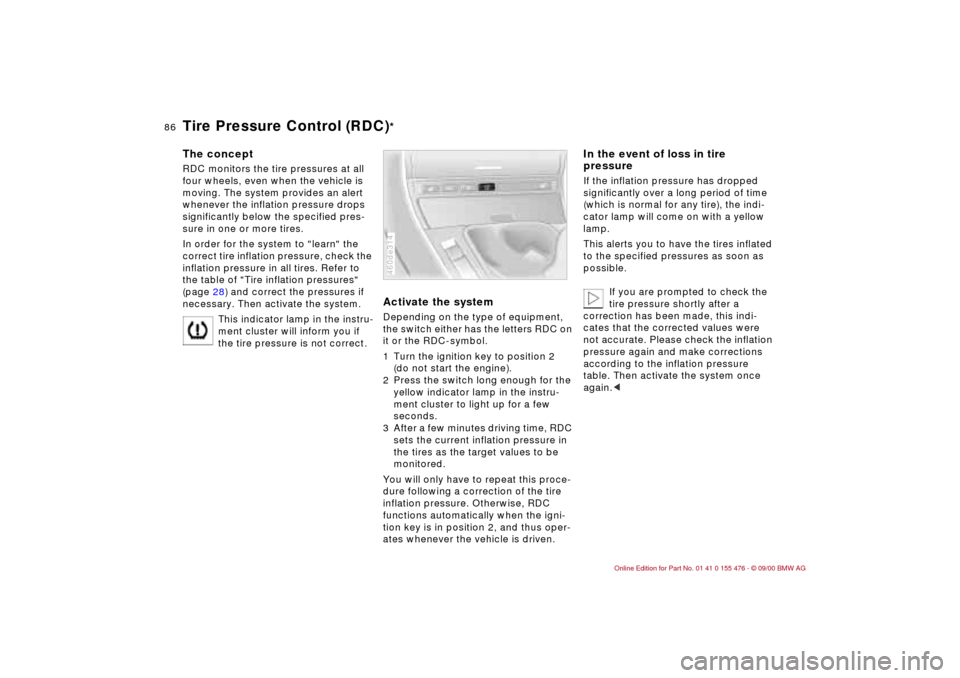
86n
Tire Pressure Control (RDC)
*
The conceptRDC monitors the tire pressures at all
four wheels, even when the vehicle is
moving. The system provides an alert
whenever the inflation pressure drops
significantly below the specified pres-
sure in one or more tires.
In order for the system to "learn" the
correct tire inflation pressure, check the
inflation pressure in all tires. Refer to
the table of "Tire inflation pressures"
(page 28) and correct the pressures if
necessary. Then activate the system.
This indicator lamp in the instru-
ment cluster will inform you if
the tire pressure is not correct.
Activate the systemDepending on the type of equipment,
the switch either has the letters RDC on
it or the RDC-symbol.
1 Turn the ignition key to position 2
(do not start the engine).
2 Press the switch long enough for the
yellow indicator lamp in the instru-
ment cluster to light up for a few
seconds.
3 After a few minutes driving time, RDC
sets the current inflation pressure in
the tires as the target values to be
monitored.
You will only have to repeat this proce-
dure following a correction of the tire
inflation pressure. Otherwise, RDC
functions automatically when the igni-
tion key is in position 2, and thus oper-
ates whenever the vehicle is driven.460de314
In the event of loss in tire
pressureIf the inflation pressure has dropped
significantly over a long period of time
(which is normal for any tire), the indi-
cator lamp will come on with a yellow
lamp.
This alerts you to have the tires inflated
to the specified pressures as soon as
possible.
If you are prompted to check the
tire pressure shortly after a
correction has been made, this indi-
cates that the corrected values were
not accurate. Please check the inflation
pressure again and make corrections
according to the inflation pressure
table. Then activate the system once
again.<
Page 88 of 211
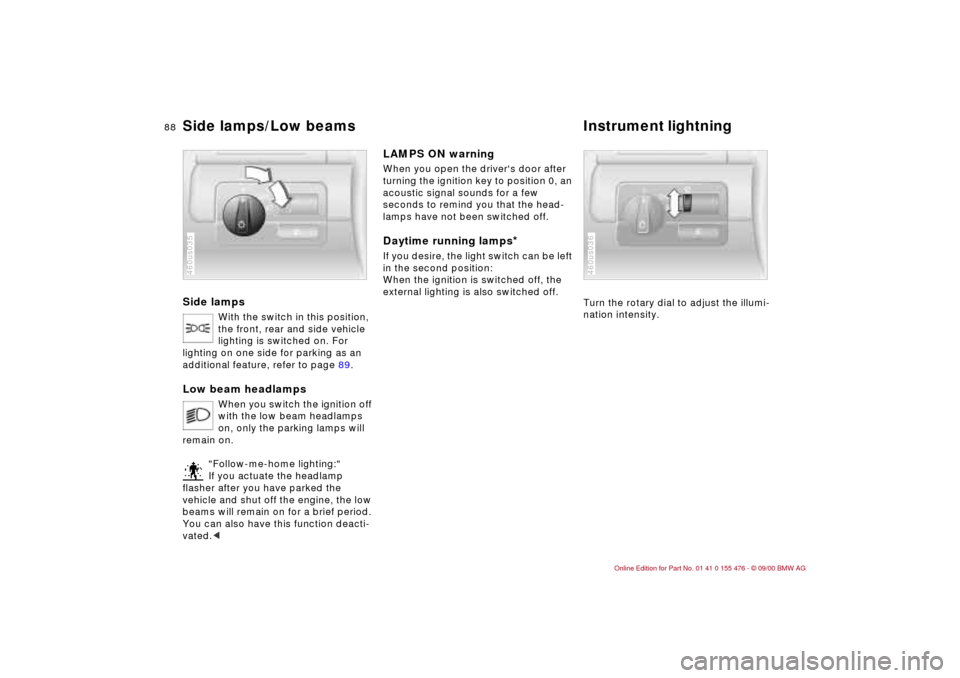
88n
Side lamps
With the switch in this position,
the front, rear and side vehicle
lighting is switched on. For
lighting on one side for parking as an
additional feature, refer to page 89.
Low beam headlamps
When you switch the ignition off
with the low beam headlamps
on, only the parking lamps will
remain on.
"Follow-me-home lighting:"
If you actuate the headlamp
flasher after you have parked the
vehicle and shut off the engine, the low
beams will remain on for a brief period.
You can also have this function deacti-
vated.<
460us035
LAMPS ON warningWhen you open the driver's door after
turning the ignition key to position 0, an
acoustic signal sounds for a few
seconds to remind you that the head-
lamps have not been switched off.Daytime running lamps
*
If you desire, the light switch can be left
in the second position:
When the ignition is switched off, the
external lighting is also switched off.
Turn the rotary dial to adjust the illumi-
nation intensity.
460us036
Side lamps/Low beams Instrument lightning
Page 89 of 211
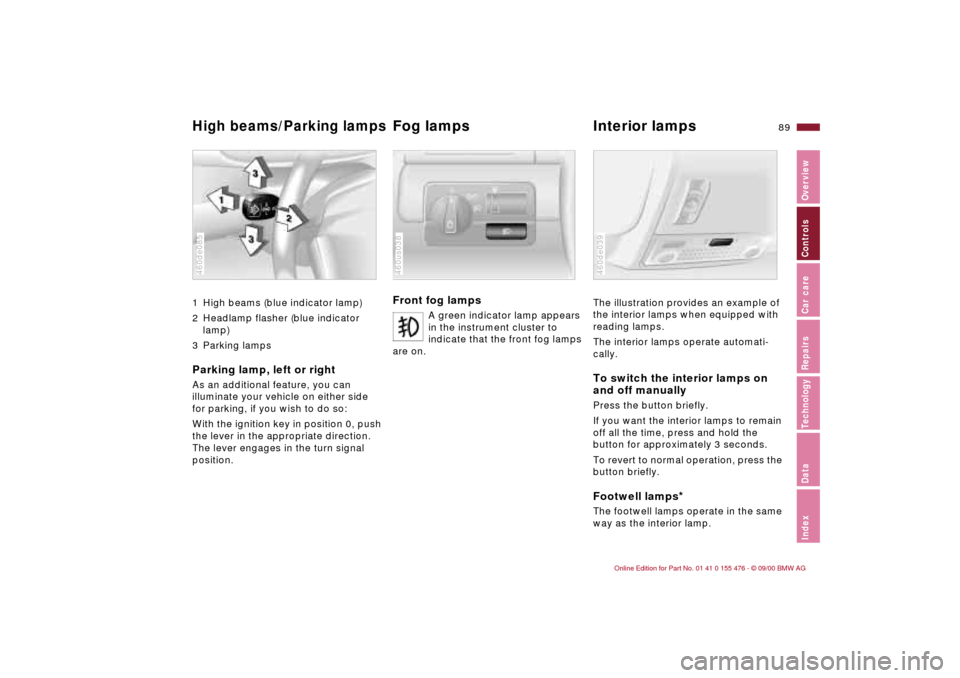
89n
IndexDataTechnologyRepairsCar careControlsOverview
High beams/Parking lamps
Fog lamps Interior lamps
1 High beams (blue indicator lamp)
2 Headlamp flasher (blue indicator
lamp)
3 Parking lamps
Parking lamp, left or right
As an additional feature, you can
illuminate your vehicle on either side
for parking, if you wish to do so:
With the ignition key in position 0, push
the lever in the appropriate direction.
The lever engages in the turn signal
position.460de085
Front fog lamps
A green indicator lamp appears
in the instrument cluster to
indicate that the front fog lamps
are on.
460us038
The illustration provides an example of
the interior lamps when equipped with
reading lamps.
The interior lamps operate automati-
cally.
To switch the interior lamps on
and off manually
Press the button briefly.
If you want the interior lamps to remain
off all the time, press and hold the
button for approximately 3 seconds.
To revert to normal operation, press the
button briefly.
Footwell lamps
*
The footwell lamps operate in the same
way as the interior lamp.460de039